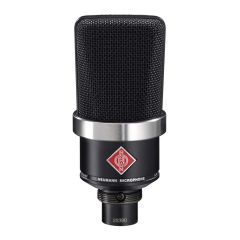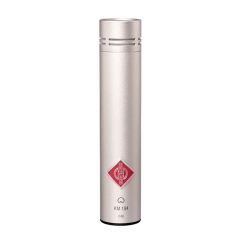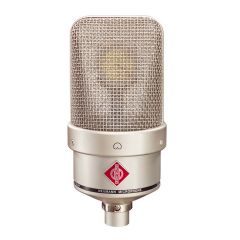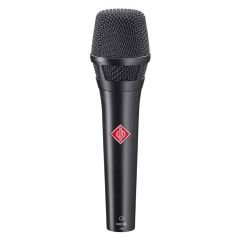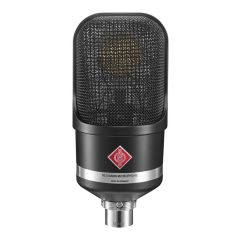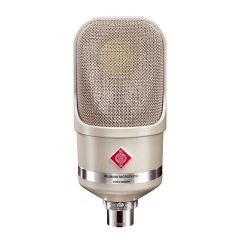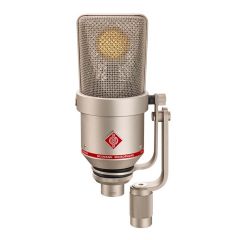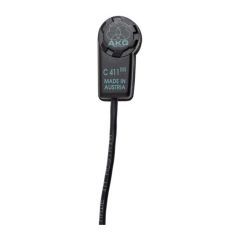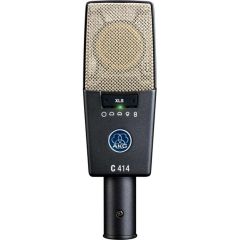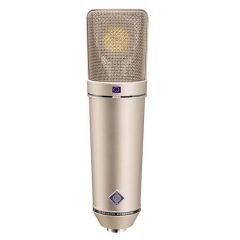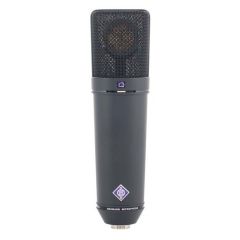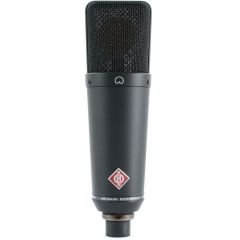Condenser Microphones
What is a condenser microphone?
Condenser microphones like the Imperative Audio Lucent Multi-Pattern Condenser Mic are perfect for recording vocals and a wide range of instruments in the studio. Each microphone brand and model offer unique characteristics and can be ideally suited to vocalists, voice-over artists, content creators, and instruments like woodwind, brass, acoustic guitars and overhead microphones for drum cymbals. While condenser microphones have a faster output, they are also more sensitive to loud sounds.
We stock a wide range of condenser microphones from brands including Neumann, Shure, RODE, Audio Technica and Imperative Audio.
How does a condenser microphone work?
The term ‘condenser’ refers to two components inside the microphone that together form a ‘capacitor’. These two components consist of a stationary back plate and a diaphragm comprised of two suspended lightweight metal plates which are highly sensitive and conductive.
When sound waves encounter the diaphragm the sound pressure causes it to vibrate against the back plate. Consequently, this leads to fluctuations in voltage between the plates, which mimics the pattern of incoming sound waves and generates an electrical signal.
As this signal on its own is not strong enough to produce an output an external power supply, commonly known as phantom power is then used to amplify the audio signal, capturing higher frequencies and providing an amplified sound.
Do condenser microphones need phantom power?
Phantom Power is commonly delivered by DC (Direct Current) power which is needed to drive the active circuitry inside the condenser microphone. Condenser microphones are usually powered by 48v Phantom Power which is delivered via an XLR cable connected to a stand-alone microphone preamp, mixer or audio interface which provides the DC power needed to activate a condenser microphone.
What is a polar pattern?
A polar pattern also known as a pick-up pattern refers to the area around a microphone that captures or is the most sensitive to sound. These patterns are often depicted in three-dimensional space and vary across microphones, determining what they are best used for. There are three types of polar pattern; cardioid, omnidirectional and figure-8 or bi-directional.
Cardioid polar patterns capture sound in a heart-shaped pattern in front of the microphone. The sides of the microphone are less sensitive but will pick up a usable amount of sound from a closer range with the rear of the microphone completely out of range. Super Cardioid and Hyper Cardioid capture sound in a similar pattern as well as having a rear-facing range.
Omnidirectional polar patterns capture sound equally in all directions, covering a 360-degree space. The size of the spherical zone can vary from microphone to microphone, but the pattern shape will stay consistent and pick up sound from any angle.
Bidirectional (figure 8) polar patterns capture sound in an area which forms the outline of a figure 8. It records sound directly in front of and directly behind the capsule without picking up sound from the sides.
Where, when and how should you use a condenser microphone?
Blumlein Technique: Using two condenser microphones placed at a 90-degree angle to each other, this method creates a natural and immersive stereo image when recording. It's like having two sensitive ears, resulting in a rich and spatial audio recording.
XY Stereo: In XY stereo recording with condenser microphones, two microphones are positioned closely together at an angle, typically 90 degrees. This setup captures a focused stereo image with excellent clarity and centre-channel definition.
Spaced Pair: When using condenser microphones in a spaced pair configuration, you place two microphones at a distance from each other, capturing a broad and expansive stereo image. It's useful for recording large sound sources like a band or creating a spacious audio atmosphere.
Mono Recording: Mono recording with a single condenser microphone captures sound in a single channel, simplifying the audio, making it perfect for situations where stereo depth is not required.
Recorderman / Glyn Johns: These specific microphone placement techniques, help capture balanced and natural drum sounds. "Recorderman" uses two condenser mics—one above the drummer and one near the floor tom, while "Glyn Johns" employs minimal setup with two overhead condenser microphones for an overall drum kit sound.
What is the difference between large and small diaphragm condenser mics?
Condenser microphones are some of the most versatile microphones around. They often come with small diaphragms and large diaphragms which can be used for different applications.
Large-diaphragm condenser microphones such as the RODE NT1 5th Generation Silver Studio Condenser Microphone typically have a diaphragm with a diameter of 1 inch (25.4mm) or greater are more commonly used for recording vocals and some acoustic instruments as they deliver a more colourful sound. They’re very sensitive and pick up a lot of low-end frequencies due to a less consistent pickup pattern.
Small-diaphragm condenser microphones typically have a diaphragm with a diameter of half an inch (12.7mm) or less with an extended low and high frequency response, this means they are great for capturing higher high-end frequencies and lower low-end frequencies. They are also capable of handling more sound pressure (SPL) before distorting and peaking. Small diaphragm condensers tend to be applied to recording instruments, such as cymbals, percussion, acoustic guitar, woodwind and brass instruments and any other instrument that requires a great deal of detail to be captured by the microphone.
Are Condenser Microphones Better Than Dynamic Microphones?
Neither a Condenser Microphone nor a Dynamic Microphone are better than the other as it is all dependent on applications and situations. Condenser Microphones have a wider frequency response and dynamic range, so can pick up more in a quieter room, like the Warm Audio WA-14 Condenser Microphone, perfect for recording vocals and acoustic instruments. Whereas Dynamic Microphones are more proficient for live sound as they are robust and much less likely to be damaged by peaking from loud sounds.
Are condenser mics good for recording electric guitar amps and cabs?
Despite what you may think condenser microphones are good for recording guitar amps and cabs as they give you a more dynamic sound than a dynamic microphone. They deliver higher highs and lower lows giving you a clearer picture of the sound; however, you should be careful with the placement and don't let the sound clip as this can damage the micrphone due its sensitivity.
We're here to help you, so if you have any questions, please contact us on sales@studiospares.com or call us on 020 8208 9930

 Price Match
Price Match Excellent support
Excellent support Trustpilot
Trustpilot FREE Delivery over £99*
FREE Delivery over £99* Spread payments with Klarna
Spread payments with Klarna